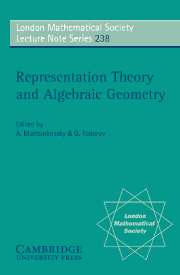Book contents
- Frontmatter
- Contents
- Preface
- Some Problems On Three-Dimensional Graded Domains
- The mathematical influence of Maurice Auslander in Mexico.
- Intertwined With Maurice
- Introduction to Koszul algebras
- Old and recent work with Maurice
- The Development of the Representation Theory of Finite Dimensional Algebras 1968 – 1975
- Algebraic Geometry Over Q
Algebraic Geometry Over Q
Published online by Cambridge University Press: 06 December 2010
- Frontmatter
- Contents
- Preface
- Some Problems On Three-Dimensional Graded Domains
- The mathematical influence of Maurice Auslander in Mexico.
- Intertwined With Maurice
- Introduction to Koszul algebras
- Old and recent work with Maurice
- The Development of the Representation Theory of Finite Dimensional Algebras 1968 – 1975
- Algebraic Geometry Over Q
Summary
In memory of Maurice Auslander
In 1978 I gave a talk at the ENS in Paris. The title was “Faisceaux arithmétiques coherents”. My goal was to introduce the mathematical public to what I called “Arakelov theory”. To justify this introduction I explained what could be done with the idea of Arakelov and Parshin: “Put metrics at infinity on vector bundles and you will have a geometric intuition of compact varieties to help you”. I also explained that my seminar [Sz 1] written in geometric language, could be considered as a book of conjectures once one knew the translation of effective divisor, Kodaira-vanishing theorem, bounded families, Hodge index etc… Needless to say I did not raise enthusiasm at this point!
I present here the work that has been done on this program.
Faisceaux arithmétiques cohérents.
Heights.
Let K be a number field. The local-global equality defining the height of a point x ∈ Pn(K) is: (with L := O{1))
where Ex is the section of Pn OK → Spec Ok corresponding to the point x. This formula teaches us many things:
(1) It is a Riemann-Roch theorem in dimension one analogous to x(L) = deg L − g + 1 on a curve.
(2)The height is the “intersection” of a scheme of dimension 1 with a cycle of codimension 1. The fundamental theorem on heights is typical of the type of results one is able to get about Q:
Theorem 1 (Northcott's theorem).
Given d ∈ N and A ∈ R+ the set
As a corollary, once one knows h (the Neron-Tate height on an abelian variety A) one gets the finitness of the torsion of A(K) because (h(P) = 0 ≤> p has torsion).
- Type
- Chapter
- Information
- Representation Theory and Algebraic Geometry , pp. 117 - 124Publisher: Cambridge University PressPrint publication year: 1997



